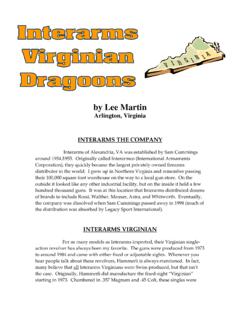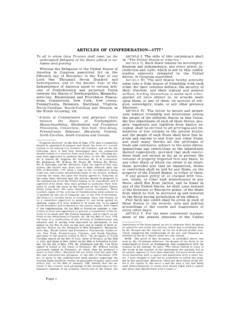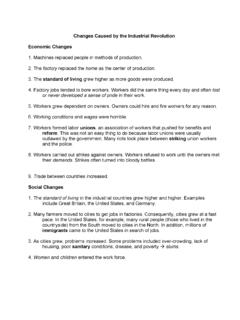Transcription of INTERARMS THE COMPANY - Single-Actions.com
1 By Lee MartinArlington, VirginiaINTERARMS THE COMPANY INTERARMS of Alexandria, VA was established by Sam Cummings around 1954/1955. Originally called Interarmco (International Armaments Corporation), they quickly became the largest privately owned firearms distributor in the world. I grew up in Northern Virginia and remember passing their 100,000 square foot warehouse on the way to a local gun store. On the outside it looked like any other industrial facility, but on the inside it held a few hundred thousand guns. It was at this location that INTERARMS distributed dozens of brands to include Rossi, Walther, Mauser, Astra, and Whitworth. Eventually, the COMPANY was dissolved when Sam Cummings passed away in 1998 (much ofthe distribution was absorbed by Legacy Sport International). INTERARMS VIRGINIAN For as many models as INTERARMS imported, their Virginian single-action revolver has always been my favorite. The guns were produced from 1973 to around 1984 and came with either fixed or adjustable sights.
2 Whenever you hear people talk about these revolvers, Hammerli is always mentioned. In fact, many believe that all INTERARMS Virginians were Swiss produced, but that isn t the case. Originally, Hammerli did manufacture the fixed-sight Virginian starting in 1973. Chambered in .357 Magnum and .45 Colt, these singles were very similar in size to a Peacekeeper and its Italian clones. The frames were color cased hardened with blued barrels and cylinders, while the backstraps were chrome plated. The predominant barrel length was , though 4 5/8 and were offered as well. The first review of the INTERARMS Virginian was in the May 1973 issue of American Rifleman, and it was a favorable one at that. At a time when numerous companies produced Peacekeeper style revolvers, the Hammerli Virginian was one of the smoothest. Unfortunately, many may have overlooked the gun if they went on appearance alone. This isn t to say that they were ugly, just that they looked like any other Colt knock-off.
3 The grips were one-piece plain walnut like the old 1873, and I believe that the two were interchangeable. The case hardening was nice, but very close in color and pattern to the Italian replicas. All were half-cock guns, used the standard blade front/notch rear sight system, and had two-piece back straps. One unique feature of the Virginian however was the Swiss Safety mechanism. Whereas many single-actions used transfer bar or anvil link systems, Hammerli employed a long base pin that contained two latch positions. The first allows the hammer to contact the firing pin, thus discharging the gun. If however it was set to the second latch, the hammer is blocked from contacting the firing pin. It s certainly not the most advanced safety system, but it does work. All Hammerli models were shipped in a red felt-lined box, used the serial prefix C-XXXX, and were imported by INTERARMS up until 1976. Although the Virginian was a very well built single-action, only a couple of thousand were ever produced.
4 They can still be found in the used market, but the ones I ve seen go for $500 and up depending on their , VIRGINIA & THE DRAGOONIn 1976, production was assumed by INTERARMS Industries of Midland, VA. The decision to break ties with Hammerli was largely based on dollar depreciation as experienced in the mid-1970s. In other words, as currency was devalued, it became unprofitable to import the Virginian. Sam Cumming s solution involved a 25,000 square foot plant that was built on the edge of a 350 acre farm. Ten of the 350 acres was for the production site, while the remaining 340 was farmed. At its peak, the staff totaled around 70, with most of the workers being long-time residents of Fauquier County. I ve been through Midland and can say that it s the last place you d expect guns to be little town, but if you blink in passing, you ve missed it. Nonetheless, Midland was convenient for three reasons: 1) It s right next to a major railway and rural airport, 2) It s only an hours drive from the INTERARMS warehouse in Alexandria, and 3) The 10 acre site provided room for expansion.
5 At this time, the adjustable sight Virginian Dragoon was introduced in .44 Magnum, with the only finish being blued & color-case. Mags and .45 Colts were catalogued, they weren t actually made until the late 70s or early 80s. It s also rumored that the Midland plant produced a few fixed-sight Dragoons from 1976 to late 1977. Though they were listed on the INTERARMS price sheet, I ve never actually seen the fixed sight variation. Unlike the old Hammerli guns, INTERARMS had the Hitchner Corporation cast a heavier frame to accommodate the .44 Magnum round. Once poured using either 4140 steel or 416 stainless, they were then shipped to Midland for final spec machining. In terms of strength and overall dimensions, these were very close to that of a Blackhawk, except the top-strap was more curved. A second noticeable difference was a slot that was cast about a quarter of an inch below the top of the frame. This characteristic became a trademark of sorts for the INTERARMS Dragoon and it does make the gun easily identifiable.
6 Another trademark is the engraving done on the bottom of the gripframe. Most Dragoons were inscribed with either Don t Tread On Me with snake logo or the untranslated Virginia state motto Sic Semper Tyrannis . The former was used on the earlier guns, circa 1976 to 1978. At least three other inscriptions exist though to include: 1) We the People 1776 1976 , 2) Yorktown 1781 1981 , and 3) Liberty Forever (see variants). Cylinder dots were also drilled to the left and right of one bore to indicate the empty chamber. It was a small enhancement, but a useful one at that. Other changes include one-piece backstraps, brazed front sights, recessed cylinders, coil mainsprings, internal firing pins, and split grip panels (note: unlike Ruger, INTERARMS used a locked firing pin bushing). Unfortunately, the walnut grips themselves are not interchangeable with any other single-action model. As a result, when buying replacement panels, you have to either go the custom route or find ones that are specific to the Virginian Dragoon.
7 Two sources include Eagle Grips @ Gun Grip @ ; I ve used both, and highly recommend Eagle over the latter. Despite the fact that the grips were hand fit to the gun, many did crack over time. I ve heard a lot of people say that the quality of the Dragoon was less than that of the old Hammerli Virginians. I d have to disagree with this statement however, at least for the guns built after 1979. While the Hammerli Virginians did have smoother actions, they were no better in terms of functional tolerances. Secondly, such a comparison makes no sense in that the Virginian was a Colt clone, whereas the Dragoon was both dimensionally and mechanically closer to a Blackhawk (internal vs. external firing pins, one-piece vs. two piece backstraps, fixed vs. variable sights, etc). Regardless, I believe that much of this opinion centers around the Dragoons made between the years of1976 1979. Indeed, some of the early guns did have timing issues and all were notorious for having rough bores.
8 Cylinder fit was good, but their finish and accuracy were mediocre. Another common problem was over-sized throats, with the .45 Colts being as large as . In hindsight though, one might expect this from a new production line, and as more guns were built, quality slowly improved. Profitability did not however, and three years into the model run, the Dragoon was still very much in the red. That s when Sam Cummings hired Rod & VARIANTSRod Sward possessed two things that were of great benefit to the Midland plant: 1) He had a strong background in production & quality oversight; his previous job had been in Florida for a COMPANY that produced ordinance fuses, and 2) He was a gun person. As a result, Sam Cummings made Rod the Vice President of INTERARMS around 1980. Along with Bud Woerheide, who was the production manager, quality and profitability improved within a matter of months. But Rod s contribution went beyond balance sheets, in that he applied a few technical innovations.
9 For instance, Rod greatly enhanced the accuracy of the silhouette model by free-boring of the barrel. Secondly, each chamber of a finished cylinder was proofed, unlike the standard practice of firing just one round. Lastly, a much greater emphasis was placed on the hand fitting and tuning of the Virginian Dragoon. In the end, these added quality controls produced Dragoons that were built to very close tolerances. In fact, the Virginians made after 1980 locked-up tighter than most factory built single-actions I ve encountered (short of those made by Freedom Arms). That includes Rugers, El Dorados, Sevilles, BFRs, Abilenes, Ubertis, Herters,.etc. Larger bolt and cylinder stops definitely contributed to this, as did extremely close fit between the two (bolt and cylinder stop widths ran within ~ of each other). Production of the INTERARMS Virginian increased significantly under Rod Sward. Within a year of his arrival, the plant was manufacturing 300 400 guns a week, and by early 1983, some 60,000 had come out of Midland.
10 What s never been well documented though is the which & when of caliber selection. The majority of the Dragoons I see are in .44 Magnum, with the .45 Colt being the next most common ..357 Magnums do exist, but they re pretty rare, and the .41 Magnum is a mystery. Early on, INTERARMS catalogued the .357 and .41 Magnums, but it wasn t until the 1980s that they became a reality. Eventually, they did churn out some .357s, but the .41s are a point of great debate. Some say that short of prototypes, they were never offered to the public. Others allege that a thousand or so .41s were produced from around 1981 to 1984. I have recently been in touch with a couple of individuals who have blued .41s, so they do exist, but are quite rare. In fact, in all my years of collecting single-actions, I ve never seen a .41 Magnum Dragoon. If anyone has pictures or information on this chambering, please drop me a line at Some other interesting variants include: Bicentenial Edition built in 1976.











